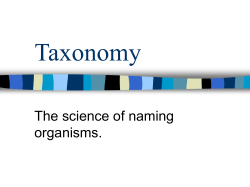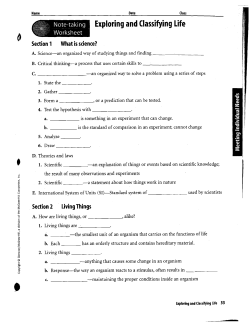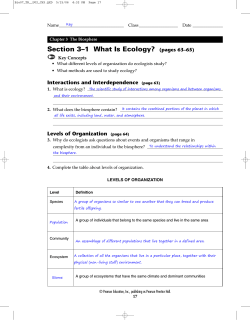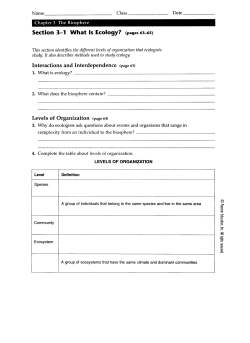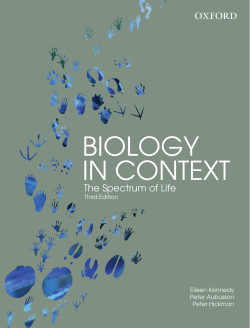
Building a phylogenetic tree 134567 Wojciech Grajkowski bio
bioscience | explained 134567 Wojciech Grajkowski Szkoła Festiwalu Nauki, ul. Ks. Trojdena 4, 02-109 Warszawa Building a phylogenetic tree Aim This activity shows how phylogenetic trees are constructed using the morphological characteristics of organisms. It is an introduction to modern systematics that classify organisms according to their evolutionary relatedness. Introduction Modern taxonomy tries to classify organisms according to their relatedness. Earlier taxonomic systems used morphological or anatomical similarities that did not always reflect true evolutionary relationships. The tree of life may be built with either morphological and anatomical structures or molecular data. Several artificial organisms are shown on the cards. These drawings have been prepared so that it is easy to find differences and to distinguish between the characteristics of each organism. No numerical data are needed to distinguish between characteristics such as long and short birds’ tails. In contrast, with real organisms a researcher must usually collect numerical data and subjectively decide how to group characteristics or, alternatively, use advanced mathematical tools. Such problems do not exist when analysing molecular data. Phylogenetic trees for even distantly-related organisms may be prepared using amino acid or nucleotide sequence data. The differences between the sequences in different organisms indicate evolutionary distances. Contact: www.sfn.edu.pl sfn@iimcb.gov.pl www.bioscience-eplained.org 1 Copyright by the author, 2011 bioscience | explained Vol 6 | No 2 In the following introductory exercise, each of three groups of students draw a phylogenetic tree for set of organisms on the cards: plants, birds or butterflies. Materials Required by each student or group • • • • Cards with pictures of the organisms (printed in colour). Worksheet with tables to fill in Paper Pencil Procedure Each person or group should analyse a different set of organisms — plants, birds or butterflies. Examples of the features used for the analysis include: number of petals, length of a tail or colour of body or abdomen. 1. Look at the organisms shown on the cards and identify seven features that differ between them. List those features in the first row of the table. Fill in the table, recording data for each of organisms, AaF. Feature Organism A B C D E F 2. Now compare each pair of organisms and, in the small table, record the total number of differences between each pair. This is the data matrix B C D E F that will be used to build the A phylogenetic tree in the next step. B 3. The numbers in the data matrix can now be used to draw C a phylogenetic tree showing D the relatedness of all six organisms. The example on the E following pages demonstrates how to do this. www.bioscience-explained.org 2 Copyright by the author, 2011 bioscience | explained Vol 6 | No 2 How to draw a phylogenetic tree In this example, there are six beetle-like organisms, labelled A to F. A C B E D F A table has been completed, listing the features of each organism: Feature Body shape Colour Head colour Antennae present? Jaws visible? Spots on back? Colour of spots A Oval Yellow White No Yes Yes Black B Oval Yellow Black No Yes Yes Black C Round Orange Black No Yes Yes Black D Oval Pink White Yes No No None E Round Pink Black Yes No No None F Round Orange Black No Yes Yes White Using the records from the first table, a data matrix, recording the number of differences between pairs of organisms, has also been produced: Currently living (extant) organisms will be placed at the top of the tree — all of the organisms analysed live in the present. Coming down the tree, we are moving into the past. The last common ancestor of the organisms will be shown on the very bottom of the tree. A A B C D E F 1 3 5 7 4 2 6 6 3 7 5 1 2 7 B C D E B 5 C F D Last common ancestor Copyright by the author, 2011 3 www.bioscience-explained.org E bioscience | explained Vol 6 | No 2 To create the tree, proceed as follows: 1. Start by finding the closest relatives — the pair or pairs of organisms that have the fewest differences between them. In this example, beetles A and B have only one difference, so they are the closest relatives. C and F also have just one difference so they are the closest relatives as well. Place these pairs at the top of the tree. The last common ancestor of A and B lived relatively recently. Mark a dot under A and B, showing the separation of evolutionary lines leading to the contemporary forms of A and B. Repeat this for C and F (Figure 1). 2. Next, find organisms that have more than one difference. B differs from C by two features, so the last common ancestor of this pair lived before the common ancestor of A and B and C and F. Draw a dot to represent the common ancestor of both of these pairs and link them together (Figure 2, left). 3. Organisms D and E also differ by just two features, so they are closely related to each other, but not to the other organisms. D and E are paired up by linking them with a common ancestor (Figure 2, right). Fig. 1 A Fig. 2 B C F A B Fig. 3 C F D E A B F C 4. Establish which organisms differ by three or four characteristics. In this way, we can confirm the earlier assumption of the relationship between A, B, C and F. 5. Next, look for organisms that differ by five features. These are beetles A and D, C and E and E and F. When there groups are linked by a common ancestor, the tree is complete (Figure 3). A www.bioscience-explained.org 4 Copyright by the author, 2011 D E bioscience | explained Vol 6 | No 2 Additional questions Can you invent names for the main groups which are visible on the tree you have created? Suggest systematic names based on the main common characteristic for each group — for example five- and seven-petalled flowers. Identify those characteristics that are convergent. Convergence is the independent evolution of the same feature in two unrelated or distantly-related groups of organisms. For example, in the plants analysed here, some of the plants lost thorns independently, and did not inherit this thornless feature from their ancestors. Convergent evolution is usually hard to unearth. With phylogenetic analysis, however, we can easily distinguish between features that are due to evolutionary relatedness (like five or seven petals) and those, like the thorns, which have appeared due to convergent evolution. What do you think of splitting the organisms into groups such as long and short beaked birds, black and grey bodied butterflies or plants with and without petals? Is this method of grouping consistent with the relatedness shown in the phylogenetic trees? Can you analyse relatedness between other organisms or even different objects like cakes or coins in the same way? Additional sources of information The Tree of Life Project: http://tolweb.org/tree/phylogeny.html Wellcome Trust Tree of Life: http://www.wellcometreeoflife.org EMBL Interactive Tree of Life: http://itol.embl.de Acknowledgments This protocol was created for the Polish biology teachers workshops ‘Biologia molekularna na początku XXI wieku’ which was a part of European project ‘Continuing Education for European Biology Teachers’ financed by the European Commission. This practical protocol was adapted for the Volvox project, which was funded under the Sixth Framework Programme of the European Commission. Copyright by the author, 2011 5 www.bioscience-explained.org Vol 6 | No 2 A D E B F C bioscience | explained www.bioscience-explained.org 6 Copyright by the author, 2011 D E B A Copyright by the author, 2011 Vol 6 | No 2 F C bioscience | explained 7 www.bioscience-explained.org Vol 6 | No 2 www.bioscience-explained.org D A E B F C bioscience | explained 8 Copyright by the author, 2011
© Copyright 2025

